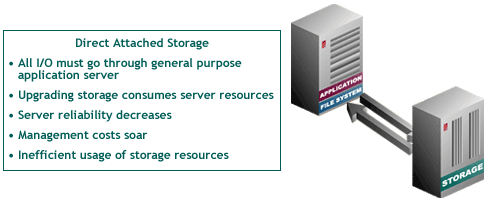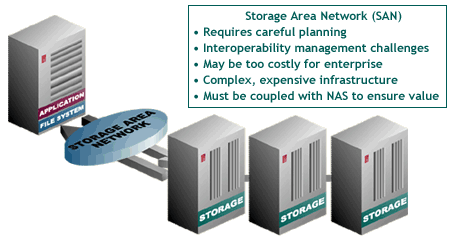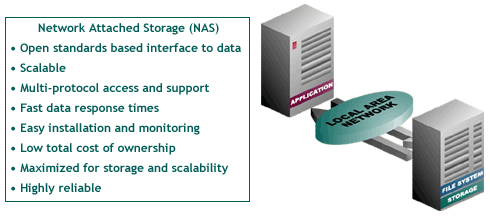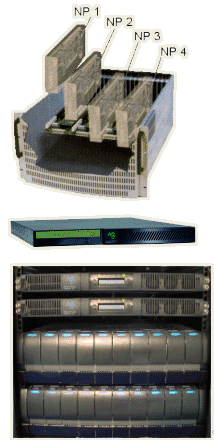Traditionally,
host servers attached to disk resources using direct connected
SCSI connections. As server data loads, volumes, and server processing
capacity increased, data I/O became a limiting factor in system
performance. Additionally, as the complexity of these systems
increased, management costs and total cost of ownership climbed
dramatically.
As
direct connected systems grow in terms of capacity and the number
of files stored, problems with performance and reliability grow
significantly. NAS based storage solve these problems
by accelerating I/O and reducing data response times, in a simple
data appliance model that is simple to install and manage.

The
problems of increasing capacity, heterogeneous system access,
manageability, and performance led to the development of the Storage
Networking industry. The Storage Networking industry includes
both the Storage Area Network (SAN) and Network Attached Storage
(NAS) product manufacturers. SAN technology today is being driven
by the various Fibre Channel manufacturers and includes both Fibre
Channel Arbitrated Loop and Fabric Switched technologies. As SAN
infrastructures become more common for consolidating storage,
NAS appliances are being integrated with SAN storage to provide
customers with solutions that deliver the best features from both
technologies.

SAN
solutions address only a portion of today’s data I/O problem.
The overriding factor for most applications is not only bandwidth,
but response times. Efficient data delivery to the client or application
sitting on the network in the terms of quick responses to data
requests is much more important to most common business applications
than streaming data rates (bandwidth). Most servers are I/O bottlenecked,
and adding additional high speed storage controllers to an already
bottlenecked server may not improve performance. By shifting I/O
loads off servers to the NAS appliance, data access improves,
and bottlenecks are broken. The Fibre Channel storage industry
is responding to two major customer desires, the need for additional
performance (bandwidth), and the ability to physically locate
storage at a distance from the host server.

Network Attached Storage provides an efficient, reliable, solution
to both these requirements today; using standards based hardware
and software.
 For example, the SPANStor line of
enabled network attached storage products eliminate the server
as a data bottleneck, delivering fast, reliable and scaleable
data access. SPANStor-GT is a highly scaleable data server that
installs easily and integrates into existing information infrastructures.
Each SPANStor-GT supports up to four Network Processors ("NP¹s"),
running on standard Intel Pentium-II hardware, in a single 19-inch
rack mount chassis. Each NP operates autonomously, providing linear
scalability, high performance, and reliable data access. The NSS
NASengine and uStor line of thin NAS appliances provide high performance
in an easily managed thin appliance. Supporting NFS, SMB/CIFS,
and HTTP protocols, the SPANStor-GT can be accessed by both UNIX
and Windows clients concurrently. Each NP can manage over a Terabyte
of data supporting multiple Ultra Wide SCSI connections at speeds
of 160 megabytes per second per SCSI interface.
For example, the SPANStor line of
enabled network attached storage products eliminate the server
as a data bottleneck, delivering fast, reliable and scaleable
data access. SPANStor-GT is a highly scaleable data server that
installs easily and integrates into existing information infrastructures.
Each SPANStor-GT supports up to four Network Processors ("NP¹s"),
running on standard Intel Pentium-II hardware, in a single 19-inch
rack mount chassis. Each NP operates autonomously, providing linear
scalability, high performance, and reliable data access. The NSS
NASengine and uStor line of thin NAS appliances provide high performance
in an easily managed thin appliance. Supporting NFS, SMB/CIFS,
and HTTP protocols, the SPANStor-GT can be accessed by both UNIX
and Windows clients concurrently. Each NP can manage over a Terabyte
of data supporting multiple Ultra Wide SCSI connections at speeds
of 160 megabytes per second per SCSI interface.
As
the number of Internet users and publishers grows, the demand
for data-rich multimedia information is growing exponentially.
Rapid data access is key to the Internet’s Information Infrastructure.
Traditional measures of performance like storage bandwidth or
throughput are rendered obsolete in an age where network clients
require rapid data response times. Increased demand stresses and
overloads the traditional servers that are directly connected
to storage resources, resulting in sluggish and erratic performance.
Network attaching storage with SPANStor provides the fast data
response times demanded by the changing Internet Information Infrastructure.
Data response times have become the key storage metric in the
Internet Information Infrastructure, and SPANStor products deliver
high performance with exceptional response times.
Network
attaching storage can reduce traffic on backbones by best locating
data on virtual sub-nets closest to the user population that most
accesses the data on a particular network processor. Backup times
are reduced with local backups on the NAS appliance keeping backup
data off the network by streaming data from the disk volumes to
tape devices attached to the NAS server. This approach permits
the tape devices to run at their streaming speed, avoiding the
stop/ start cycles (shoe-shine) of the tape transport which greatly
reduces throughput. SPANStor supports both a Native Backup mode
and the Network Data Management Protocol (NDMP). NDMP enables
the NAS appliance to fulfill backup and restore commands locally
for high performance, yet operate under the control of a host
based NDMP compliant backup program from vendors like Legato,
Veritas, or Workstation Solutions. For more information on NDMP
visit the NDMP web site at URL http://www.ndmp.org.
NAS
servers or appliances are designed to provide industry standard
interfaces to information, in a fast, reliable, easy to manage
device. For more information on SPANStor products or any of our NAS appliances call
us or
.